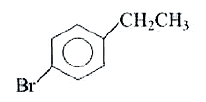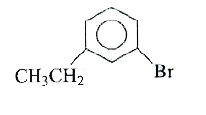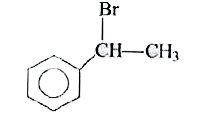Bromination of methane in presence of sunlight is a
nucleophilic substitution
free radical substitution
electrophilic substitution
nucleophilic addition
The correct Answer is:B
To determine the type of reaction that occurs during the bromination of methane in the presence of sunlight, we can break down the process step by step.
1. Identify the Reactants and Conditions:
- The reactants are methane (CH₄) and bromine (Br₂).
- The reaction occurs in the presence of sunlight, which provides the energy needed for the reaction to proceed.
Hint: Look for the role of sunlight in initiating the reaction.
2. Understand the Nature of the Reaction:
- The reaction involves the substitution of one hydrogen atom in methane with a bromine atom, resulting in the formation of bromomethane (CH₃Br) and hydrogen bromide (HBr).
Hint: Identify what type of atoms or groups are being replaced in the reactants.
3. Mechanism of the Reaction:
- The bromination of methane proceeds through a mechanism known as free radical substitution, which consists of three main steps: initiation, propagation, and termination.
Hint: Familiarize yourself with the three steps of free radical mechanisms.
4. Initiation Step:
- In the presence of sunlight, bromine molecules undergo homolytic cleavage, producing two bromine radicals (Br•).
- Reaction: Br₂ → 2 Br•
Hint: Consider how energy from sunlight can break bonds in molecules.
5. Propagation Steps:
- In the first propagation step, a bromine radical reacts with methane, resulting in the formation of a methyl radical (CH₃•) and hydrogen bromide (HBr).
- Reaction: CH₄ + Br• → CH₃• + HBr
- In the second propagation step, the methyl radical reacts with another bromine radical to form bromomethane and regenerate a bromine radical.
- Reaction: CH₃• + Br• → CH₃Br + Br•
Hint: Look for the formation of radicals and how they react with each other.
6. Termination Step:
- The reaction can terminate when two radicals combine to form a stable product, such as two bromine radicals forming bromine or two methyl radicals forming ethane.
- Reaction: Br• + Br• → Br₂ or CH₃• + CH₃• → C₂H₆
Hint: Think about how radicals can combine to stop the chain reaction.
7. Conclusion:
- Since the reaction involves the substitution of a hydrogen atom by a bromine atom through a radical mechanism, the correct classification of the reaction is free radical substitution.
Final Answer: The bromination of methane in the presence of sunlight is a free radical substitution reaction (Option 2).
- The reactants are methane (CH₄) and bromine (Br₂).
- The reaction occurs in the presence of sunlight, which provides the energy needed for the reaction to proceed.
- The reaction involves the substitution of one hydrogen atom in methane with a bromine atom, resulting in the formation of bromomethane (CH₃Br) and hydrogen bromide (HBr).
- The bromination of methane proceeds through a mechanism known as free radical substitution, which consists of three main steps: initiation, propagation, and termination.
- In the presence of sunlight, bromine molecules undergo homolytic cleavage, producing two bromine radicals (Br•).
- Reaction: Br₂ → 2 Br•
- In the first propagation step, a bromine radical reacts with methane, resulting in the formation of a methyl radical (CH₃•) and hydrogen bromide (HBr).
- Reaction: CH₄ + Br• → CH₃• + HBr
- In the second propagation step, the methyl radical reacts with another bromine radical to form bromomethane and regenerate a bromine radical.
- Reaction: CH₃• + Br• → CH₃Br + Br•
- The reaction can terminate when two radicals combine to form a stable product, such as two bromine radicals forming bromine or two methyl radicals forming ethane.
- Reaction: Br• + Br• → Br₂ or CH₃• + CH₃• → C₂H₆
- Since the reaction involves the substitution of a hydrogen atom by a bromine atom through a radical mechanism, the correct classification of the reaction is free radical substitution.
Topper's Solved these Questions
- HALOALKANES AND HALOARENESBOOK - NCERT FINGERTPS ENGLISHCHAPTER - HALOALKANES AND HALOARENESEXERCISE - Physical properties
7 Videos
- HALOALKANES AND HALOARENESBOOK - NCERT FINGERTPS ENGLISHCHAPTER - HALOALKANES AND HALOARENESEXERCISE - Chemical reactions
68 Videos
- HALOALKANES AND HALOARENESBOOK - NCERT FINGERTPS ENGLISHCHAPTER - HALOALKANES AND HALOARENESEXERCISE - Nomenclature
6 Videos
- GENERAL PRINCIPLES AND PROCESSES OF ISOLATION OF ELEMENTSBOOK - NCERT FINGERTPS ENGLISHCHAPTER - GENERAL PRINCIPLES AND PROCESSES OF ISOLATION OF ELEMENTSEXERCISE - Assertion And Reason
15 Videos
- POLYMERS BOOK - NCERT FINGERTPS ENGLISHCHAPTER - POLYMERS EXERCISE - NCERT Exemplar
9 Videos
Similar Questions
Which hydrogen in compound (E) is easily replaceable during bromination reaction in presence of light ?

View SolutionComplete the statements by filling in the blank with the correct word/s:
Decomposition of silver salts in the presence of sunlight is an example of __________[double decomposition/photochemical decomposition]
View Solution
Knowledge Check
Which of the following will be obtained by the bromination of ethylbenze in presence of light ?
A B
B C
C D
D
2-methylbutane on reacting with bromine in the presence of sunlight gives mainly
A1-bromo-3-methylbutaneB2-bromo-3-methylbutaneC2-bromo-2-methylbutaneD1-bromo-2-methylbutaneWhich of the following molecules of alkane will give only one monohalohenated product on reaction with halogen in presence of sunlight?
AH3C−CH3BH3C−CH2−CH3C(H3C)4CD
Chlorination of methane proceeds by
View SolutionWhich hydrogen in compound (E) is easily replaceable during bromination reaction in presence of light ?
CH3δ−CH2γ−CHβ=CH2α(E)
View SolutionThe bromination of aniline in presence of water produces :
View SolutionThe main product of the reaction of propane with chlorine at 25∘C in the presence of sunlight is
View SolutionThe reaction of chlorine with CO in the presence of sunlight gives :
View Solution
